








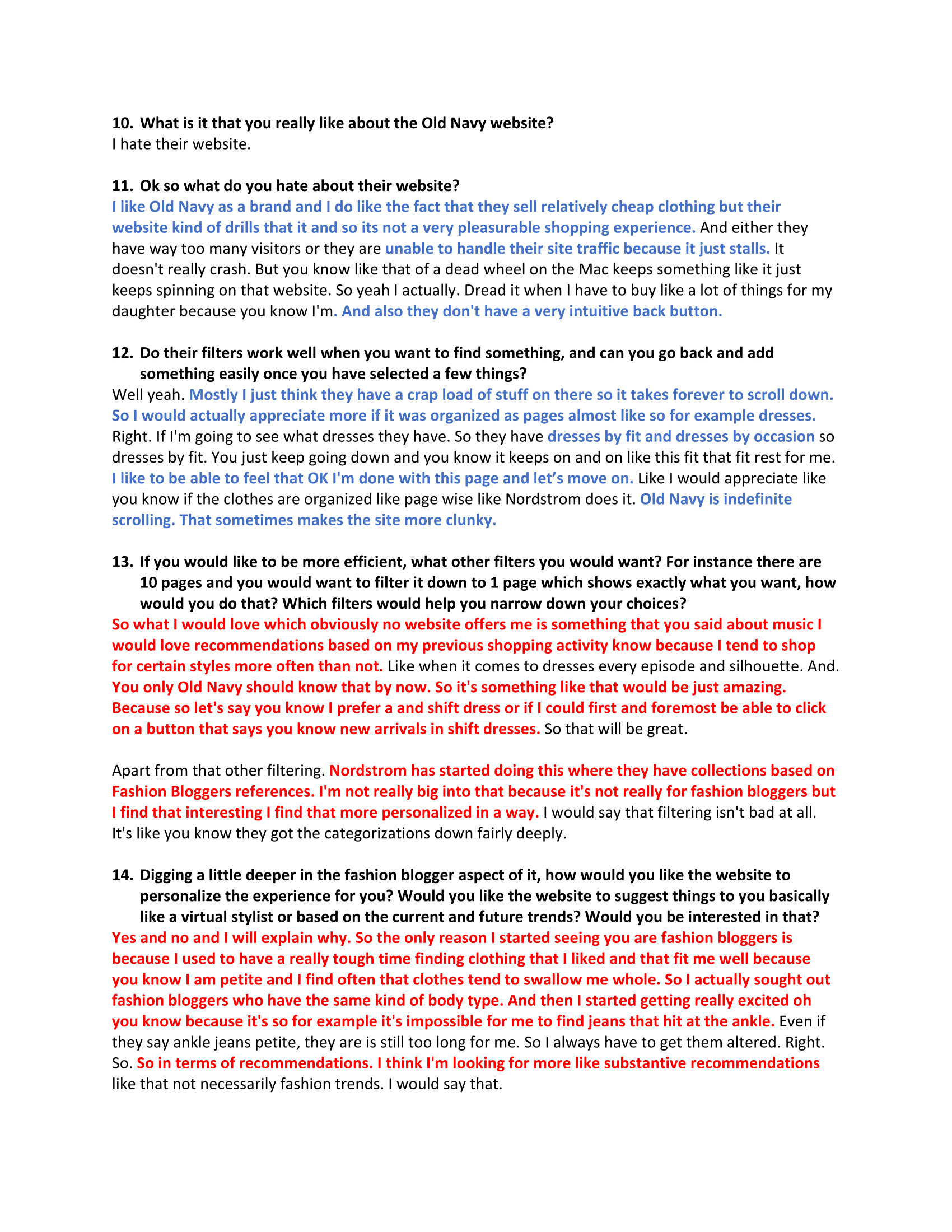



































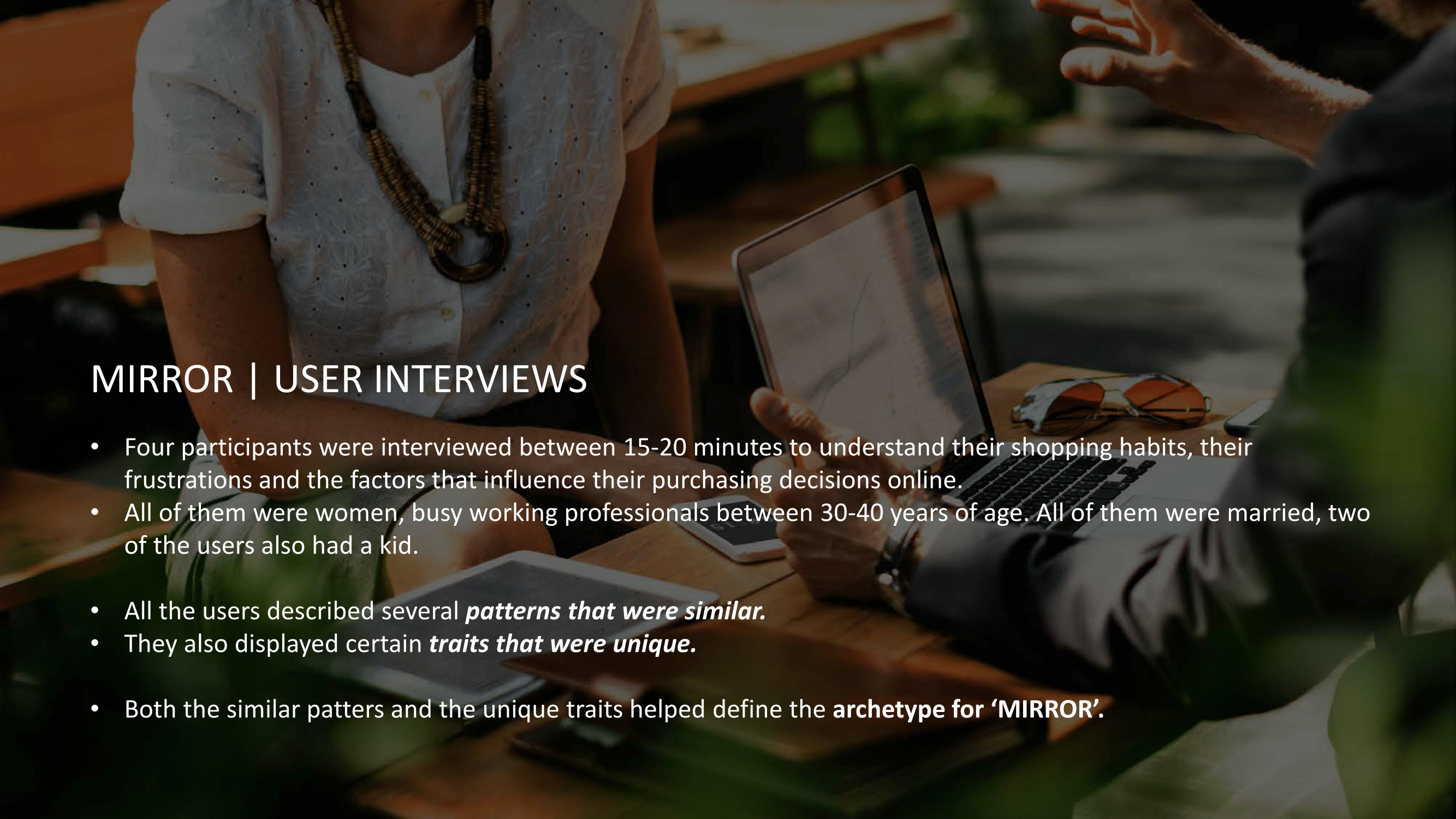















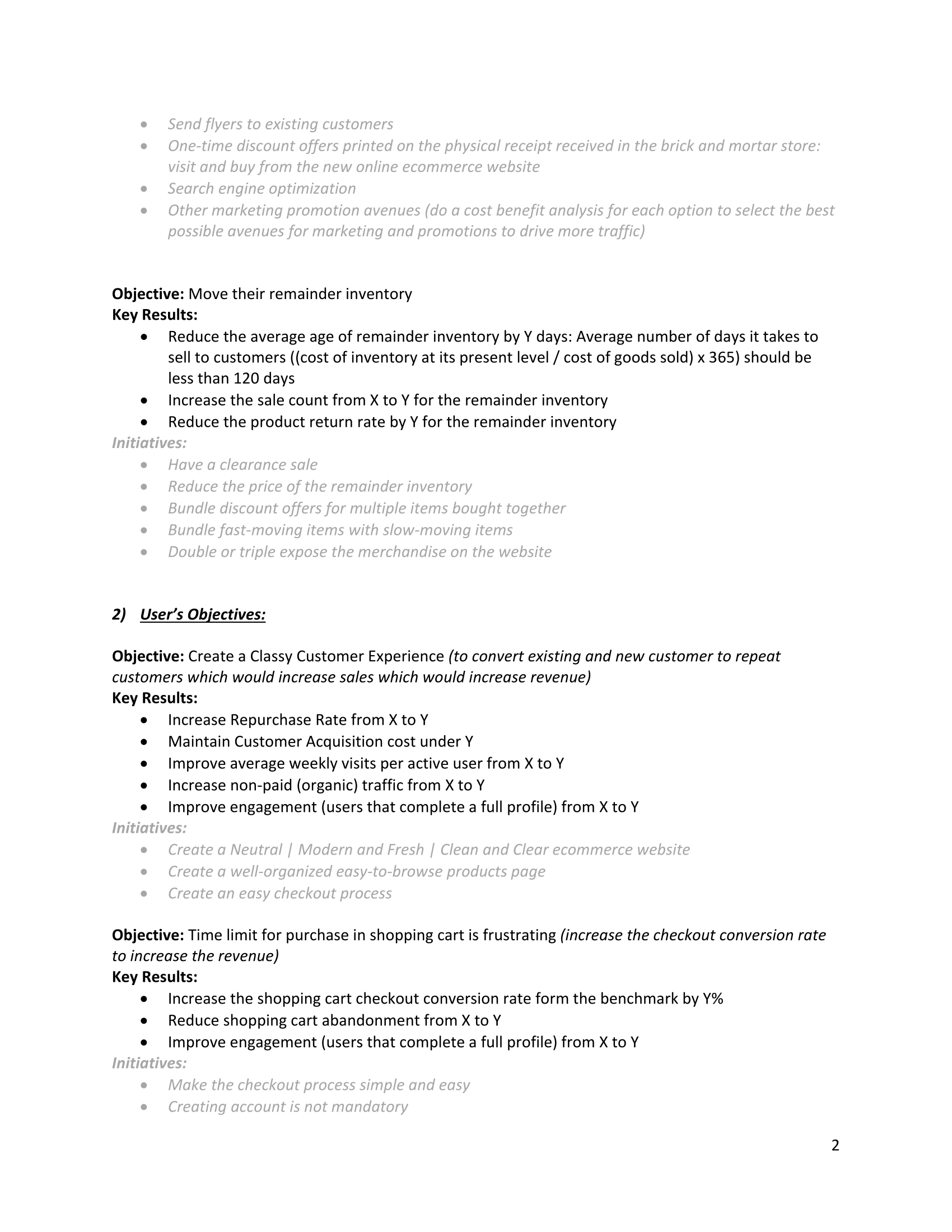






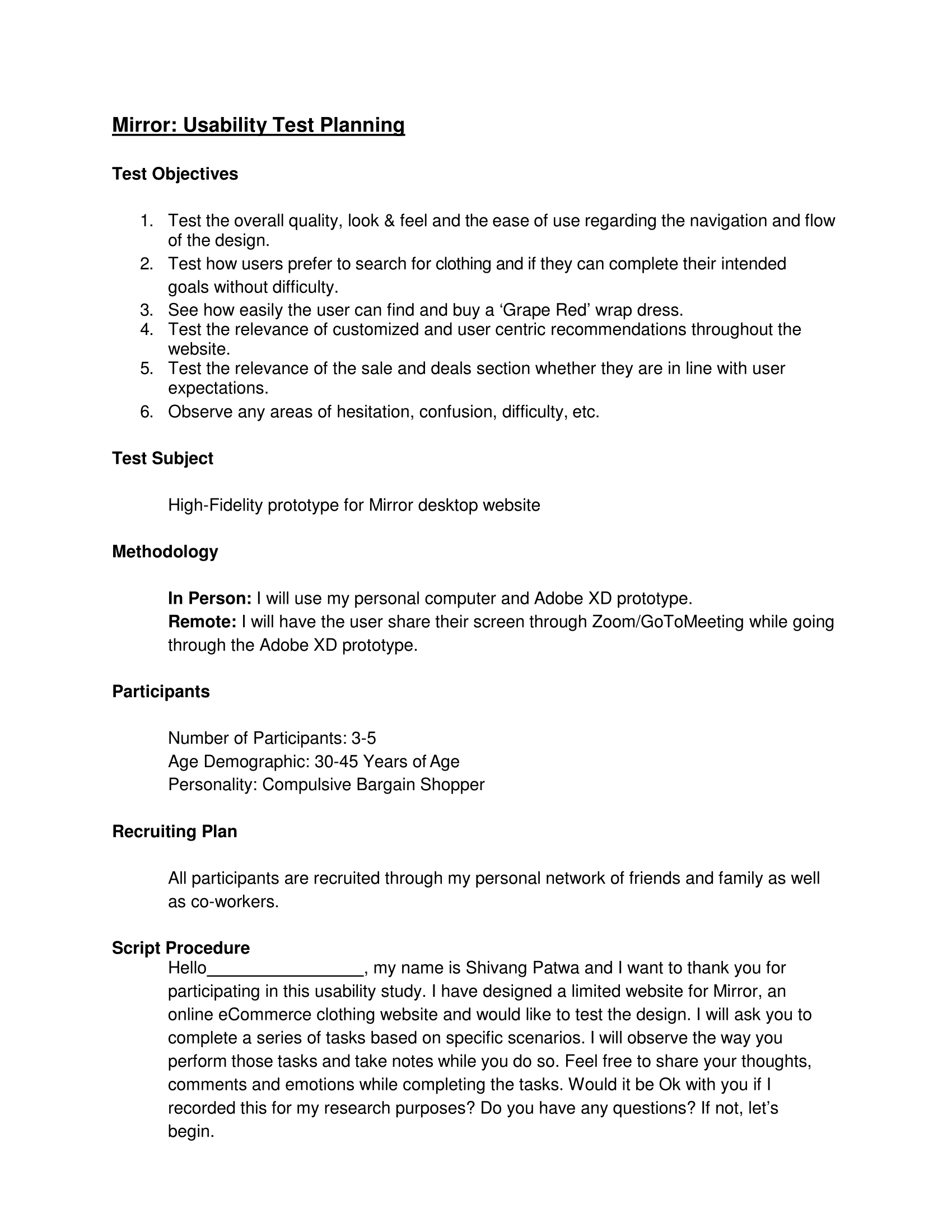









People who take transit: Interested in bicycling to the transit station, but are concerned
(professional with a set routine and has started to bicycle to the transit station due to traffic congestion)
The comprehensive app will consists of various functions like log in/registration, dashboard, locations, history, billing, help and logout. This project will specifically focus on the aspect of renting a shared eLocker by booking it 24 hours in advance through the app 'Dashboard'.
Create the process of booking/renting the eLocker within the 'eLocker' app 24-hours in advance
(choose the location, check availability, choose the locker, select the start and end times, book the rental)
User Experience Designer | Product Designer
Generative Research
Competitor Analysis
User Interviews
Research Findings
UX Strategy Blueprint
Persona
Empathy Map
Storyboard
Project Goals
Site Map
Design Alternatives
Task Flow & User Flow
Product Requirements
Wireframes | Responsive
Moodboard and Style Tile
High Fidelity Prototype
Usability Testing and Results
Affinity Map
Priority Revisions
UI Kit
Hand Off
A lot of people live in suburbs where the accessible transit station is outside of the comfortable 20-minute walking distance, while their workplace in the city maybe within walking distance from the transit station. Most of us, in our daily lives, follow a set pattern: wake up, get fresh, have breakfast, get ready, travel and go to work. Out of all these activities, the one that acquires most of our time is commuting. Driving is not always the fastest or the most convenient option. The lack of speedy transport options for the first and last mile is termed as the “last mile problem”.
'eLocker' provides a viable alternative for eliminating public transit’s first-mile/last-mile problem by giving a way to book ‘eLocker’ (secure/shared bicycle parking) at transit stations ahead of time. This would avoid the hassle of searching for an available locker or not finding a locker at all since all of them have been taken, while you are rushing to take the public transit for work.
The ideal 'eLocker' app users are 'People who prefer transit'
and are interested in biking but are concerned about safety and logistics.
Analysis and synthesis of the 1-1 interviews lead to the following insights:
- Provide secure shared eLockers at transit stations that can be booked beforehand
- Show availability of shared eLockers at the various transit station in real-time
- Show locations of shared eLockers at the transit station to calculate transfer time
to help reduce transfer logistics anxiety
- Have the option of adding minutes to your start or end rental times
if you are running late or are caught up at work/home.

Making it easier for people to combine bicycling and transit can improve access to jobs, contribute to healthier lifestyles, reduce personal and household transportation costs, and increase transportation choices. This in turn would help improve transit ridership and reduce traffic congestion. We began by looking at secondary research about bicycling and access to transit all over the bay area.
We also analyzed the strengths and weaknesses of other bicycle storage/locking systems like bicycle racks, 'Bikeep' high security racks and other bicycle parking areas including open and close enclosures at transit stations.
A few things that stood out about existing bicycle storage/locking systems:
- They were easy to use but were not secure.
- They could not store other bicycle accessories like helmets, shoes, U-lock, etc.
- The bicycles were exposed to the elements on the open bike racks/enclosures.
- They were not conveniently located at the transit stations which made transfer logistic
annoying and confusing.
- Individual bicycle locker boxes could only be used by a single user who had signed a long term
rental agreement with the transit authority and was provided with a key.
Seven participants (four women and three men) were interviewed to understand who they were, their lifestyle and their interest/reservations regarding bicycling to the transit station for their daily commute. Questions were asked to get insights into their pain points, deterrents and apprehension regarding using a combination of bicycling and transit as their daily mode of transport. We also wanted to understand their motivations for bicycling and using public transit. The users ranged from 35 to 54 years of age. We quickly realized the most important factors for them to be able to bicycle to the transit station for their daily commute were 'safety, storage and transfer logistics'.
Based on initial research, people that are willing to consider riding their bicycle to the transit station (bus or a train)
likely fall into three categories:
1. People who would ideally prefer to make a short walking trip to transit, but their origin/destination is too far from the stop for this to be practical. A significant portion of these potential users are likely “Interested but Concerned” about bicycling.
2. People who would ideally prefer to bicycle for the full duration of their trip, but their trip is too long, too hilly, or the weather isn’t conducive to bicycling on that day. Many of these potential users may be enthusiastic and confident or interested but concerned bicyclists who would not consider leaving their bike locked at a station all day unless long-term bicycle parking offers them a secure option.
3. People who would ideally prefer to drive but rely on transit to access the places they need to go on a daily basis. Neither transit nor bicycling may be this group’s first choice, but they may ride a bicycle to a transit stop because walking distances are unreasonably long, because they are too young to drive, or because car ownership is not economically viable or efficient for them. The focus for these users should be on providing safe access with minimal delay.
Who are we designing for?

From the interview data a persona and an empathy map was created representing the main user group: People who take transit: Interested in bicycling to the transit station, but are concerned. The persona focuses on Oscar Quine, a middle-aged Architect working at a Design firm in San Francisco.
He lives with his wife and two kids in a house in Berkeley hills. North Berkeley Bart station is about 2.2 miles away from his house. It takes about 12 minutes down-hill and 22 minutes-up hill on his bicycle to and from the Bart station. He likes to ride his bicycle to Bart but is worried about it getting stolen or not finding a spot to securely park his bicycle at the transit station.


Based on this need we decided to focus on designing a solution that would allow Oscar to book a eLocker rental beforehand so he can 'safely store his bicycle' and plan for the 'transfer logistics' at the transit station. We generated a number of sketches with various ideas and then developed a hybrid option that was an amalgamation of various elements from different sketches to refine further. Final sketches were put into a storyboard to show the screen flow from beginning to end.
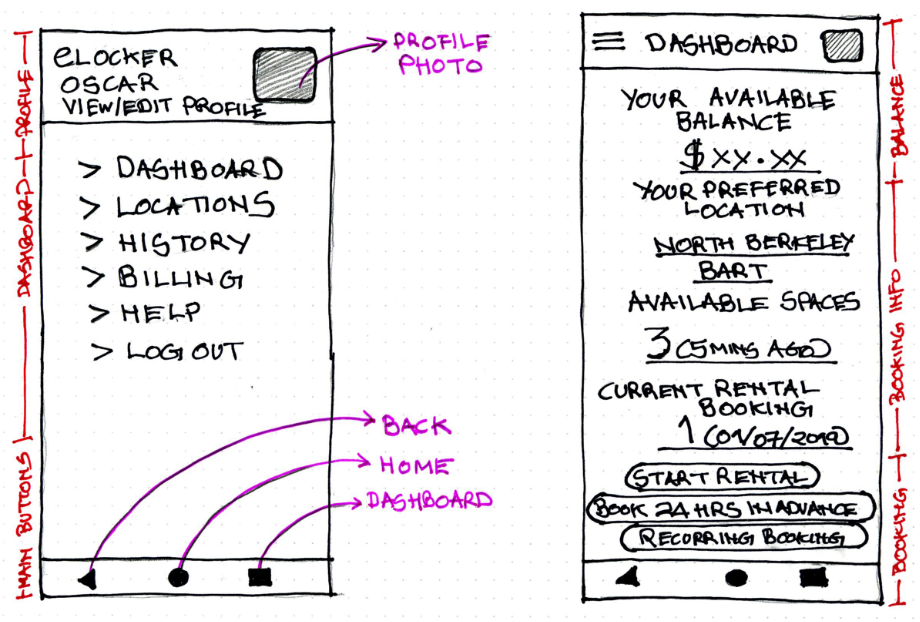

Using the storyboard both a taskflow and a userflow was mapped out for 'Oscar'. The userflow shows how Oscar use the 'Dashboard' to make a rental booking for the eLocker 24-Hrs in advance at his preferred transit station.


Referring to the storyboard and userflow, low fidelity wireframes were built.
Emphasis was put on:
- Creating an easy, simple and efficient booking process
- Giving information about location and availability of eLockers at transit stations
- Providing a convenient way of recurring booking for regular daily trips
- Giving a way to add time to the start and end rentals if you are running late






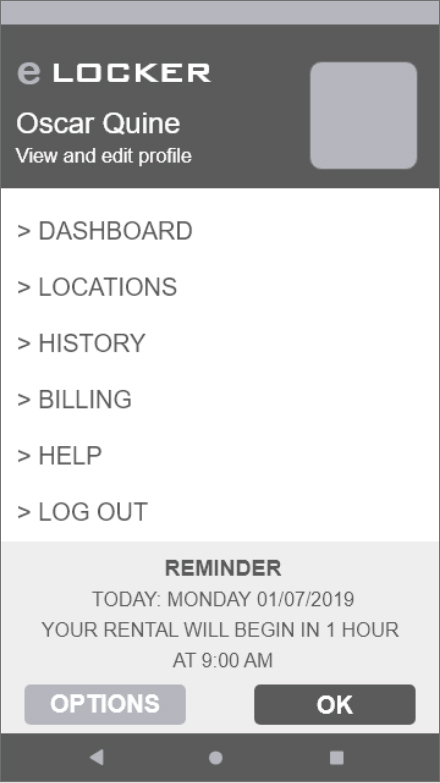

The brand created for eLocker represents accessible secure shared bicycle parking for all. Dark blue and light orange were chosen as the primary colors to represent the values of innovation and sustainable bicycling solutions. The logo embodies the qualities depicting safety and security. Since there is a lot of text a simple typeface was chosen to give the brand a clean and accessible look.


High fidelity prototypes for usability testing were created using the mood board and style guide as reference






The wireframes were then used to create a high-fidelity prototype for usability testing. Tests were conducted with six users who closely aligned with the target user group of people who wanted to ride their bicycle to the transit station. The users were asked a few questions about their bicycling experience and were then given the test. The users were asked to book a rental of the shared eLocker at North Berkeley Bart Station:
Task 1: Log into their account and book a rental of the lower level eLocker from their Dashboard.
Task 2: Add 15 minutes to their start time of their existing rental booking.
Everybody could complete the task easily without much of a problem. They liked the graphics showing the eLocker. Some users noted that there could be just a few options to add time to the rental. They also noted that a few of the lockers should always be available on site for first come first serve basis that are not open for prior booking.
This feedback helped us iterate upon the initial designs and ultimately create a more user-friendly experience. Priority revisions were made before hand off using Avocode.







Making it easier for people to combine bicycling and transit can improve access to jobs, contribute to healthier lifestyles, reduce personal and household transportation costs, and increase transportation choices.
The research highlights the fact that there are tremendous opportunities to increase rates of bike-to-transit trips. Rates of bicycling to and from transit stops are low in large part due to challenging conditions for bicycling along many of the major corridors that connect to transit, and a lack of adequate bike parking at transit stops for easy transfer.
Time permitting, the app can be further developed to include other features like:
- Transfer times and connection logistics
- Rewards/Penalty system for using eLockers
- Usage demand/timing data analysis to plan for future infrastructure
Being a UX Designer you always think about the user: how can you make their lives better through design? In this case by providing an effective solution to address the last mile problem: booking a shared eLocker at the transit station beforehand.